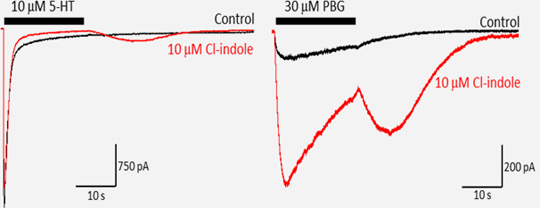Ago-Allosteric Modulation of the 5-HT3A Receptor via the Orthosteric Site: involvement of partial agonists
The human (h) 5-HT3A receptor is a member of the cys-loop ligand-gated ion channel (LGIC) family, regarded as a prototypical model for the family. We have recently demonstrated positive allosteric modulation of this receptor by 5-chloroindole (Cl-indole; Newman et al., Br. J. Pharmacol. 169: 1228-1238, 2013). In the present study we have further explored the mechanism of action of Cl-indole at the h5-HT3A receptor, with particular attention on its effect on responses evoked by partial agonists. Whole-cell patch clamp recordings were made from HEK-293 cells expressing the h5-HT3A receptor. Receptor currents were evoked by a 20 second picospritz application of either 5-HT, meta-chlorophenylbiguanide (mCPBG) or phenylbiguanide (PBG). Cl-indole was bath applied via a gravity-fed perfusion system. When using a full agonist (5-HT), Cl-indole did not potentiate 5-HT3A receptor currents, whereas responses evoked by partial agonists were potentiated by Cl-indole (table 1). The kinetics of agonist-induced receptor currents were unaffected by Cl-indole (figure 1).
Table 1 – Cl-indole potentiates 5-HT3A receptor responses evoked by partial agonists but not full agonists.
Figure 1 – Cl-indole evokes tail currents after application of both full and partial agonists. In the absence of Cl-indole, current returned to baseline after removal of agonist (black trace). In constrast, removal of agonist in the presence of Cl-indole (red trace) induced a tail current with slow activation and deactivation kinetics. We have previously demonstrated that Cl-indole induced tail currents following removal of 5-HT (Grafton et al., this meeting). Cl-indole induced qualitatively similar tail currents following the removal of partial agonists. We propose that Cl-indole modulates h5-HT3A receptor responses by interacting with the orthosteric site, but only in the presence of an orthosteric agonist. This mechanism of action is similar regardless of whether a full or partial agonist occupies the orthosteric site, but in the presence of a partial agonist, Cl-indole is able to promote transition through the “priming” step that limits receptor activation.
|



